Do Anti Aging Creams Work? (Hint: Yes!)
So, do anti aging creams work? In other words, is anti aging skincare effective?
The (very) short answer is: it certainly can be; most certainly, yes.
The (very) long answer starts right below.
There are things we can do to prevent premature aging (see What Causes Skin to Age: Reasons & Prevention). A quick recap here:
- Avoid overexposure to the sun rays (this is the number 1 cause of premature aging!)
- Make sure to have a healthy lifestyle (no smoking, avoid alcohol if possible or drink in moderation, good foods, get enough sleep, avoid polluted areas)
- Use good, natural and/or organic anti aging skincare (you need to learn what to buy that is EFFECTIVE for your mature skin as well as skin type)
Aging affects our skin. Full stop. The above will help your skin and you can get started as soon as TODAY with new, healthier habits (easier than what people think).
Indeed, with aging, the skin loses some of its properties, such as elasticity, thickness, and colour
Source
High performance anti aging skincare will play such an important role after you take care of keeping a healthy lifestyle as well as protecting yourself from the sun rays.
Can Simple & Natural Solutions Have a GENUINE Effect Upon Aging of the Skin?
Yes!
- There is a lot of scientific data that has been published in the journals regarding natural ingredients having an effect on aging skin
- Natural compounds have been studied and proven to work on aging skin
- There is evidence that natural, botanical cosmetics (plant-based) do work on aging skin (and, they do a really good job!)
As I create my own high-performing antiaging skincare I make sure to look up recent discoveries in the scientific world to do with plant-based ingredients as well as learning as much as possible about past discoveries and tests.
There are SO MANY new ingredients appearing in the botanical market that are incredibly interesting. There’s more availability ias time goes by (20 years ago only a few oils were available for purchase while nowadays there are an incredible range of vegetable oils you can easily purchase both online and in stores).
I constantly read about this subject and try to make my formulas the best they can possibly be. Sometimes I do like to use ingredients on their own (hydrosols are a good example) because they already are packed with incredible benefits.
Watch out for new ingredients in the anti aging organic market; I’ll be writing about them here on this website to make sure you are aware of the latest exciting opportunities.
Ok, now that you know that botanical ingredients can (and will) make a difference to your skin in terms of their anti aging properties, let’s have a look at what you want your anti aging products to do.
What You Want Your Anti Aging Products to Do
In my article What Causes Skin to Age: Reasons & Prevention we looked at the reasons why you would want to use the right anti aging skincare.
There are many changes your skin experiences over time, and these are the changes your anti aging natural skincare should be tackling:
- Your skin gets drier
- Your skin feels rougher
- Appearance of fine lines
- Appearance of wrinkles
- Hyperpigmentation
- Loss of elasticity
- Loss of bounciness
- Your skin becomes more fragile and transparent
You should always find out everything you can about the skincare product you’re using. There’s all sorts of information available online so there’s no excuse.
The same way you need to know what you put into your body when it comes to food, you should also know what you put into your skin in terms of skincare.
The efficacy of anti aging skincare needs to be proved. These products can be extremely expensive (check out this video) and I find that sometimes it is not necessary to go for such high-end cosmetics (I’m not saying they don’t work! I’m saying that other ingredients and products work really well on your skin when it comes to their anti aging properties).
Your anti aging cosmetic should work on the above concerns. It should be designed with these concerns in mind and use ingredients that tackle them (one or more).
Obviously aging occurs all over your body, but it is around your face, neck, decolletage and hands that these signs are more obvious.
Let’s have a look below at what we want our anti aging skincare products to work on in terms of functions and the concerns we looked at above.
1. Give Strength & Support to the Skin’s Barrier Function with Moisturizers
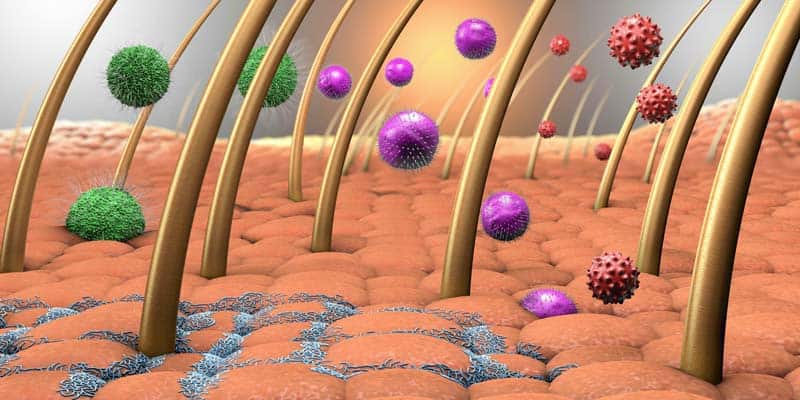
(Strengthening and supporting the skin’s barrier function aims at improving dry skin, inflammation, fragility, transparency)
Supporting and giving strength to our skin’s barrier function is the VERY BASIC when it comes to ANY anti aging skincare product!
The importance of skin barrier cannot be overemphasized. The skin barrier is important to human life. Physically, it protects from external threats such as infectious agents, chemicals, systemic toxicity and allergens. Internally, the skin helps to maintain homeostasis and protects from enhanced loss of water from the body.
Source
I want to keep things simple so they’re easy to understand, but I will mention some technical aspects of the skin’s barrier function at times like I will do right below.
Just bear with me, it is quite easy to understand if you have a little patience.
- Filaggrin, a protein, plays an important role in skin barrier function (1,2). It is important for the formation of the corneocyte, and the generation of its intracellular metabolites.
- The oils in the outermost layer of the skin, the stratum corneum (cholesterol, free fatty acids and ceramides)
- Tight junctions
- Antimicrobial peptides
- Biological variations
The epidermis generates protective and defensive functions mediated by …] the stratum corneum. Of these functions, most critical is the permeability barrier, which retards transcutaneous evaporative water loss… The stratum corneum is a multilayered tissue composed of […] corneocytes […] enriched in ceramides, cholesterol, and free fatty acids.
Source
The oils in the stratum corneum (outermost layer of the skin) are crucial for the function of our skin as a barrier. As I pointed out above (and also the quote mentions it), they’re composed of:
- Cholesterol
- Free fatty acids
- Ceramides
These are hidrophobic (repel water) and so they don’t let the water escape from our body. This is what transepidermal water loss means (losing water via the dermis or skin).
In simple words: there’s a layer of oil sitting at the very top of our skin making sure water doesn’t evaporate from inside out.
Antimicrobial Barrier & Permeability Barrier
These two skin barrier functions (not letting microbes in – antimicrobial and not letting water out – permeability) are co-regulated as well as interdependent.
ANTIMICROBIAL – When our skin barrier gets disrupted we get ‘cracks’ that let in external agents and foreign matter like sweat and allergens (think of a microbial invasion of allergy triggers like dust, mites and mould) that can cause inflammation of the skin. That’s how we get diseases like atopic dermatitis which result in itching, dry skin and eczema.
PERMEABILITIY – The problem is that these cracks also allow water to leave our body (what’s known as transepidermal water loss). Because of this permeability moisture evaporates FROM INSIDE OUR BODY easily and as a result our skin gets even drier.
The tight junctions mentioned above form are ‘bidirectional’, which means they actually form a barrier to both sides (water loss from inside and external agents and toxic chemicals coming in from the outside). Dust, mites, etc have no way to go in when the tight junctions are healthy and there are no cracks.
Also, abundant antimicrobial peptides in the skin are a great contribution to the barrier function. These peptides are generated in the deeper layers of the outer skin, and then transported to the outermost layer of the skin (stratum corneum) where they play a vital role in being the first line of defence against potential pathogens. These peptides kill the pathogens as well as helping in wound healing, balancing immune responses and cell differenciation and more.
When the barrier is disrupted and external agents are allowed to enter we also experience a degradation of the collagen, elastin and hyaluronic acid in our skin (more on these here).
Just to have a little bit more info below you can have a really quick look at the protective functions of the outer epidermis. DO SKIP IF YOU WANT TO, the above is more than enough info to get you to understand how your skin’s barrier function works.
- Permeability (water passing through) > Ceramides, cholesterol, nonessential fatty acids in proper ratio
- Antimicrobial (microbial invasion from outside in) > Antimicrobial peptides, free fatty acids, sphingsine
- Antioxidant > Cholesterol, free fatty acids, secreted vitamin E, redox gradient
- Desquamation (cohesion) > Intercellular DSG1/DSC1 homodimers
- Chemical exclusion > Hydrophilic products of corneodesmosomes
- Hydration > Filaggrin proteolytic products; glycerol
- Ultraviolet light > Trans-urocanic acid (histidase activity)
Again, don’t worry too much around the above bulleted points. All you need to know is that there is a solution to restore your skin’s barrier function.
What’s the solution?
Moisturisers. We need to feed our skin with the right moisturiser.
We all have different skin barriers and also our barrier changes as we age. It is important that you understand this in order to know how to maintain your skin as healthy as possible and always providing the best protection to it.
Finding the right moisturizer for your skin barrier will take time and it is a matter of trial and error. But over time you get to know your ingredients and which products work well FOR YOUR SKIN. Moisturizers alter the thickness of your stratum corneum (outermost layer).
Because this outermost layer is both water-loving and oil-loving we can apply water based products and oil based products (creams are in fact a mix of water an oil, much like mayonnaise).
We have, in fact, 3 different types of moisturisers:
- Humectants: these attract water onto our skin. Examples are honey and glycerin.
- Emollients: Are good for softening and smoothing our skin. Examples are carrier oils like almond oil or olive oil
- Occlusives: Provide an excellent barrier by sitting on top of our skin. Examples are cocoa butter (the approved barrier ingredients recognised by the FDA are dimethicone, cocoa butter and allantoin even though so many butters and oils are naturally occlusive).
When I apply facial oils I can see how different oils add different thickness to my skin. With practise, time and lots of pampering you get to ‘learn’ how your skin reacts with the different ingredients and cosmetics.
You need to learn what your skin loves over time. This is something you need to be patient with.
2. Protect Your Skin from Inflammation & Photoaging with Antioxidants
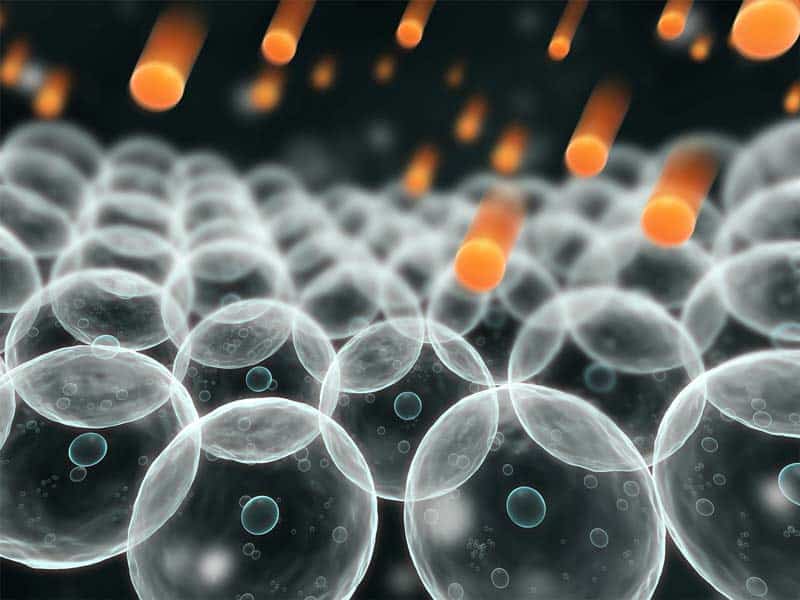
(Protecting the skin with antioxidants aims at improving appearance of wrinkles, loss of elasticity and loss of firmness).
Skin photoaging is a consequence of the oxidative stress generated upon exposure to UV radiation. However, the skin is normally protected from the negative effects of oxidative stress by endogenous antioxidant systems, which, unfortunately, undergo a progressive decline during aging.
Source
We saw in my article What Causes Skin to Age: Reasons & Prevention that free radicals can become abundant and create what is known as ‘oxidative stress’ (a chain reaction where more and more free radicals are formed).
If you want to go into the nitty-gritty of what free radicals are and what oxidative stress causes your skin please read the article above. All I want to say here is that antioxidants play a very important role protecting our skin. They help reduce the effects of UV rays which causes what is known as ‘photoaging’.
Intracellular and extracellular oxidative stress initiated by reactive oxygen species advance skin aging, which is characterized by wrinkles and atypical pigmentation. […] The use of antioxidants is an effective approach to prevent symptoms related to photo-induced aging of the skin.
Source
Look at this diagram, it makes it a bit simpler to understand:
UV light > reactive oxygen species > oxidative stress > photoaging.
There are several external factors that can cause free radical production: air, water, pollution, smoking, used oil and fat in the kitchen although it is the sun that can cause the most damage.
Nowadays, sunlight is among the most harmful exogenous factors able to induce ROS formation. The spectrum of sunlight includes infrared energy (above 760 nm), visible light (400–760 nm), and ultraviolet (UV) light (below 400 nm) [49]. UV radiations can be further divided in UVA (400–315 nm), UVB (315–280 nm), and UVC (280–100 nm). Photobiological responses are mostly generated by exposure to UVB and UVA radiations. UV radiations are the major cause of stem cell DNA damage; they can contribute to depletion of stem cells and damage of stem cell niche, eventually leading to photoinduced skin aging.
Source
3. Promote Skin Rejuvenation with AHAs
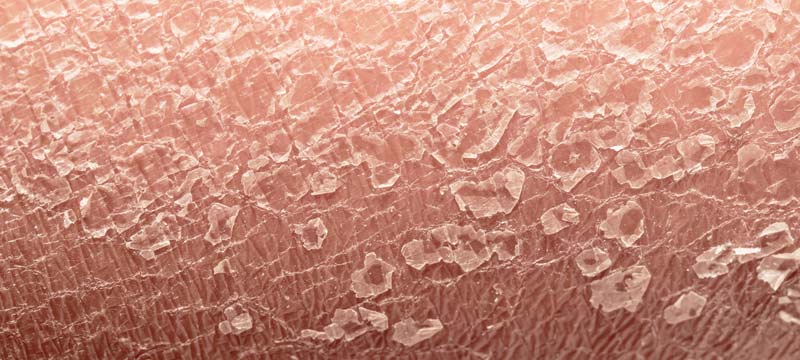
(Promoting skin rejuvenation aims at improving the appearance of rough and/or dull skin)
As we get older our skin will start to appear dull and rough. This is down to our skin’s cellular turnover which does slow down over time.
α- (alpha) and β- (beta) hydroxy acids help speeding up the restoration of our top layer of the skin (epidermis). Think that these ingredients – α- (alpha) & β- (beta) hydroxy acids – help when it comes to sloughing off the dead skin cells which means that the younger skin underneath is revealed.
This is not all. Skin rejuvenation can also help reduce the effects of photoageing and also reduce age spots.
4. Tackle Hyperpigmentation
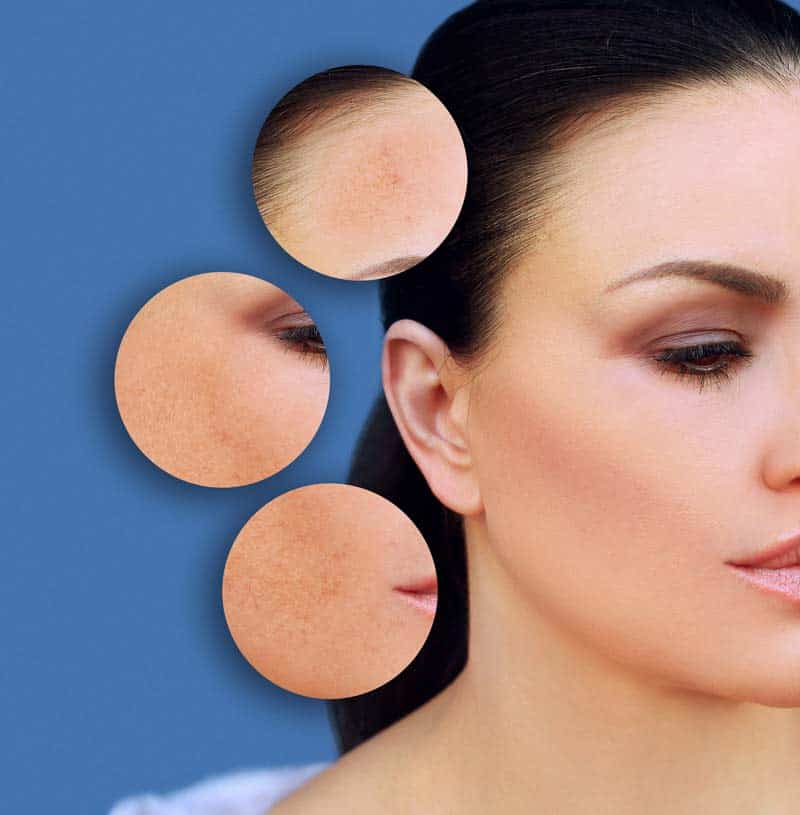
(Tackling hyperpigmentation aims at improving age spots).
Hyperpigmentation occurs when part of the skin becomes darker than its surrounding skin because of an excess of the brown pigment called melanin which is in charge of producing the colour of our skin.
Some cosmetics help reducing hyperpigmentation without taking it too far by causing a loss of colour in the skin or even irritation.
The best thing is always to try and avoid too much sun exposure. I am always careful and try to apply sunscreen on my face, neck, decolletage, arms and hands although living in such a hot place (Tenerife, the Canary Islands) I can never be careful enough.
By using peeling agents the melanin can be removed from the skin outer layer (epidermis). Always use these peeling agents with caution!
5. Stimulate Connective Tissue Production
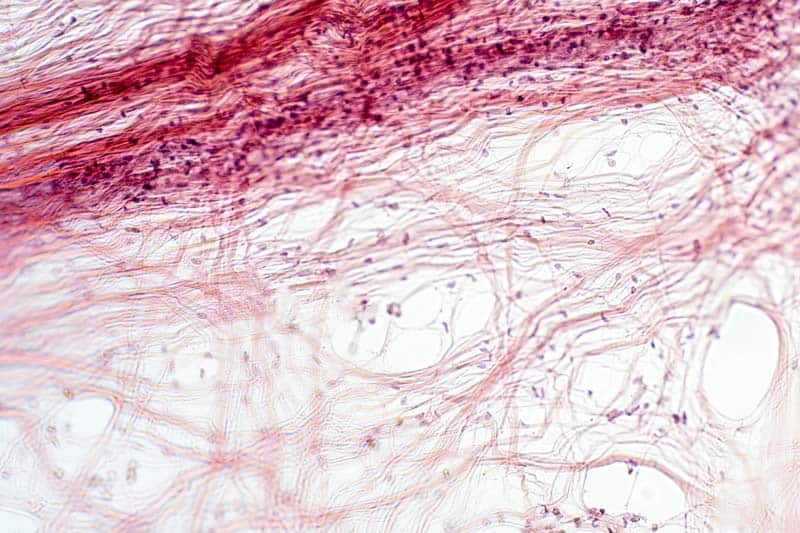
(Stimulating connective tissue production aims at improving wrinkles, skin fragility, loss of elasticity and loss of firmness).
It is well known that essential oils do penetrate the skin and into our blood but not many cosmetic products can do the same.
In order to treat deep wrinkles the best thing is to be able to prevent them as much as we can. Cosmetic products can’t really restore degradation of collagen, elastin and hyaluronic acid but we can use certain ingredients that can help stimulate their production.
Retinoids and Vitamin C are an example.
Note that it is important to look at reducing inflammation of the skin because it helps degrade these 3 constituents (collagen, elastin and hyaluronic acid) so preventing inflammation helps prevent wrinkles! The same can be said about antioxidants which help with the process.
Conclusion
These are the functions anti-age cosmetics should perform (by tackling one or more of the above mentioned).
Support
ABOUT THE SKIN BARRIER FUNCTION
Skin Barrier Function (IJMR)
Stratum Corneum Lipids: Their Role for the Skin Barrier Function in Healthy Subjects and Atopic Dermatitis Patients
Skin Barrier Function (HHS Public Access)
ANTIOXIDANTS
Role of Antoxidants in the Skin: Anti Aging Effects
Role of Antioxidants in the Protection from Aging-Related Diseases
